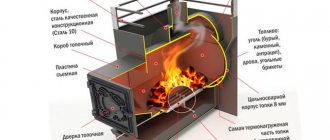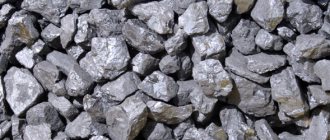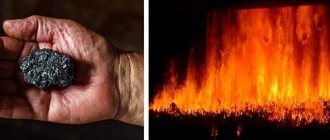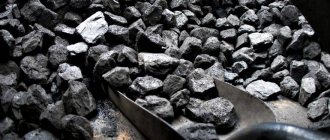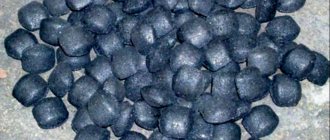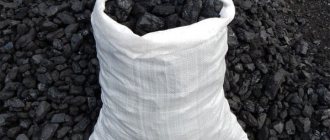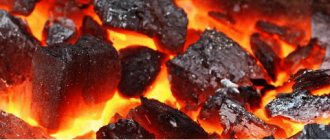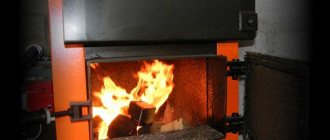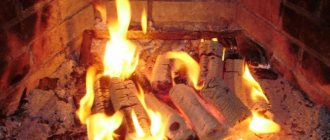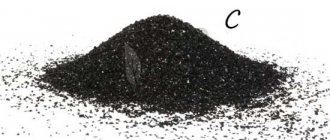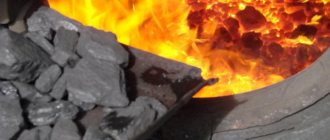Why is coal watered?
4. Loading fuel, as a rule, should begin from the front of the grate, avoiding the formation of burnouts, achieving an even, dazzling white fire over the entire area of the grate.
5. When loading fuel, after each thrown shovel of coal, you should close the door of the scoop hole, producing heating with a slam; This technique prevents excessive cooling of the firebox.
6. Throwing in coal should be done as often as possible, in small portions of 4-6 shovels, avoiding loading in a heap, but throwing in the coal loosely, like a fan.
7. During steady combustion, fuel should be added crosswise, covering only part of the burning layer with a fresh layer.
8. The air flow into the firebox should be adjusted according to need, combining the opening of the siphon, the blower valves and the position of the variable cone bulb, avoiding sudden changes in the combustion process.
9. The use of cutters and lances, inevitable during prolonged heating, requires great care. Taking into account the individual properties of burning fuel, it is necessary, if possible, not to destroy the coke layer and not mix it with the slag.
10. Heating on the way should be carried out taking into account the nature of the profile and with continuous monitoring of the layer of burning fuel. If there is a heavy area, you should begin to increase the load on the firebox and boost the heating in advance. Towards the end of a difficult section, it is necessary to gradually reduce the load on the firebox, gradually weakening the intensity of combustion.
11. Heating should be carried out in strict accordance with the water supply to the boiler. The boiler must be fed through the injector in small portions in the intervals between two loadings of fuel, not allowing the steam pressure to decrease by more than 0.5 atm during the pumping of water.
12. Approaching the final station or an intermediate point where the furnace is cleaned, you should gradually reduce the fire, burning out the coke in the layer and burning it out of the slag.
Preparing coal before loading it into the furnace
Wetting of the coal should be done during the next pumping of water into the boiler, avoiding special pumping only for watering. When wetting the coal, it is necessary to mix it, bringing the mass of coal to the state of a uniform, steep, dough-like slurry. The more fines the coal contains, the more abundantly it should be moistened. However, we should not forget that excessive wetting is harmful.
Wetting of coal has as its main task to reduce the entrainment of fine dry coal into the pipe. In addition, the water contained in the moistened coal, entering the firebox with it and evaporating, leaves small funnel-shaped channels in the burning layer. These channels increase the surface of contact between the air and the fuel layer and thereby contribute to good, active combustion.
Types of coal and their characteristics
Coal is a natural fuel. It consists of flammable carbons and various impurities that do not burn. The quality and classification of raw materials depends on the ratio of such substances. The age of the fossil also affects the grade of fuel.
Several types of coal are used to light stoves - brown, anthracite, lingite or stone. Each fuel group has its own characteristics and features of use for stoves.
Brown coal
Due to its low carbon content, large amount of water and volatile compounds, brown coal has a low heat of combustion. Therefore, it is classified as a low category fuel. The color of this still “young” geological deposit is brown.
Brown coal consists of 30-40 percent moisture. A significant proportion is occupied by volatile substances, and the carbons necessary for combustion can range from 50 to 70 percent. When stored outdoors, the density of raw materials is significantly reduced. This occurs as a result of water evaporation. Prolonged exposure to the open air leads to the transformation of the fossil into powder.
What does brown coal look like?
Brown coal is used quite rarely for heating stoves. It is mainly used in subsidiary farms. The use of such raw materials for the firebox leads to excessive clogging of the chimney pipe with soot. When burning, a pungent odor and smoke are released, and after burning, quite a lot of ash is formed.
Lingit
This fuel is classified as a type of brown coal. Lingite is considered the “youngest” fossil. In some countries it is not classified as coal due to its too loose structure. It contains up to 45 percent water and the same amount of sulfur. This fuel has a brown tint. Often the name “black lingite” refers to subbituminous coal.
The use of such fuel is completely limited, since its combustion characteristics are somewhat lower than those of brown coal.
Coal
This type of raw material is best suited for furnace devices. Its deposits are located deeper and are formed under high temperature and pressure. The nitrogen content in such raw materials depends on its type and can reach 95 percent. Thanks to this, coal has good physical and chemical properties and is a fairly valuable fuel.
The raw material contains a low level of moisture - up to 32 percent and a lot of flammable substances. The specific heat of its combustion is 5.5 kcal/kg. The color of coal can be black or dark gray.
Wetting - coal
Some experimental studies on the influence of the gas phase on the wetting of coal with cryolite-alumina melt were carried out in 1952 by Vaina [37], and then by the authors of this book. Lastly, to establish the influence of the gas phase and at the same time the composition of the salt phase, we measured the contact angles of melts of the systems: A1F3 - NaF and Na3AlF6 - A12O3 on carbon plates in an atmosphere of Ar, N2, CO2 and air. The results of these measurements show that the value of the contact angle 6 depends on the gas phase in the following way: the smallest values of the contact angles for all the studied melts were obtained in an air atmosphere, and the largest in an atmosphere of dry argon. [16]
The optimal moisture content of coal should be about 50%; at this humidity, the wetting of the coal occurs most evenly and, therefore, the interaction between humic acids and ammonia is most complete [3, p. Low humidity leads to large losses of nitrogen, since ammonia water is slowly absorbed by coal . [17]
Coal as a well-forgotten future
Russia ranks first in the world in terms of proven coal reserves.
However, over the past thirty years, the use of this fuel in our country has decreased significantly. Now certain regions of the Russian Federation are sitting on a “gas needle”, and this, when the supply of gaseous fuel is stopped or at low atmospheric temperatures (-25 ° C or less), has already led and may in the future lead to emergency situations. The widespread replacement of coal with liquid and gaseous fuels has led to a decrease in its share in the fuel balance of our country to 8-10 percent.
At the same time, coal consumption in economically developed countries has increased by 200 percent and continues to rise. Currently, about forty percent of all electrical energy - for example in the UK, USA, France and Canada - is generated by burning coal. According to forecasts, consumption of this type of fuel in developed countries should reach about 250 percent of 1975 levels by 2022.
Why isn't coal used?
The decline in the share of coal consumption in Russia is caused by a number of objective reasons: large volumes of oil and gas production; complexity, labor intensity and low automation of the fuel preparation process; outdated technologies and long-term technology for preparing coal for combustion; number of service personnel; relatively low calorific value of coal; a significant proportion of non-combustible mineral inclusions and impurities in coal, including those that form environmentally hazardous substances when exposed to different temperatures during chemical reactions; the formation of a large amount of solidly bound ash, slag and coke deposits on heating surfaces during the combustion process; technical difficulties in operating the fuel economy of combustion plants; high maintenance costs and other reasons. In addition, important factors for the reduction in coal consumption were the deep crisis in the Russian economy in the 1990s, the loss of highly qualified specialists and the low level of implementation of effective technologies for the preparation and combustion of coal.
Benefits of use
Coal is the most common natural resource in Russia. Moreover, its extraction is carried out mainly by open-pit mining, so this type of solid fuel is the cheapest fuel in our country. The use of coal, compared to the use of liquid or gaseous fuels, does not require sealed high-pressure pumping and supply systems and tanks: storing and supplying coal for combustion is a less explosive and fire-hazardous operation than similar processes with liquid and gaseous fuels; the highest calorie content of the combustible part; simpler fuel economy.
There are other benefits too. A positive aspect in the use of this type of fuel is its huge natural reserves, exceeding the reserves of oil and natural gas. This must be used for the economic recovery of Russia.
In the context of the constant rise in price of hydrocarbon energy carriers, the use of coal is the most economically profitable in various sectors of the Russian economy, especially in coal-mining regions.
Why are new technologies not being introduced?
The transition of the Russian energy sector to liquid and gaseous fuels has led to a decrease in the volume of industrial consumption of coal and decreased interest in this type of fuel. In this regard, the introduction of modern technologies that have long been used in economically developed countries has ceased.
The lack of demand is also due to the lack of financial resources for scientific development, a sharp reduction in the number of scientists and engineers working on coal issues, and a misunderstanding of this issue.
One of the arguments against the use of coal is the high level of harmful emissions of combustion products. However, new technologies have been and are still being developed in our country.
To ensure that tomorrow there is no shortage of heat and light, it is necessary today to create conditions for scientists and allocate funds for the implementation of existing new technologies.
Combustion Features
It is known that any hydrocarbon fuel, including coal, burns in a gaseous state. In this case, the efficiency of the combustion process (i.e., the largest amount of thermal energy received) along with other factors is determined by the ratio of carbon and hydrogen (C/H) in the combustible part of the fuel.
However, in contrast to gaseous or liquid hydrocarbon fuels, the quality of the coal combustion process and the amount of energy produced is greatly influenced by the structure of the fuel, the shape and size of coal particles, the moisture content of coal and other factors.
For primary heating, heating and ignition of coal particles, a supply of thermal energy is required - the so-called backlight - otherwise the combustion process stops. Coal combustion begins when the temperature of carbon oxidation is reached (about +950...+1050 °C), and gaseous products formed as a result of the release of volatile substances do not prevent the access of air oxygen to the burned fuel.
When heat is supplied to coal particles, their thin surface layer quickly heats up and their inner layers are evenly heated. In this case, air diffuses into the inner layers of the fuel, which leads to its luminosity, slow and uniform decomposition, the release of a significant amount of volatile components, as well as the release of thermal energy.
Combustion technologies
Coal preparation and combustion technologies developed during the 19th and 20th centuries as industrial consumption increased.
Today, many technologies for preparing and burning coal are used. However, technologies that combine both high economic efficiency and high environmental friendliness are of practical interest. These technologies include: • pseudo-flare combustion of a dust-coal-air mixture; • flare combustion of coal-water suspension; • combustion of coal in a fluidized bed; • low-temperature vortex combustion method.
Let's look at these technologies in more detail.
Pseudo-flaring
Preparation of coal for this combustion method involves dry grinding of the original fuel with a moisture content of up to 21 percent in centrifugal mills until homogeneous coal particles with an average size (dispersity) of 50-300 microns are obtained, forming coal dust.
The prepared dust enters a vibrating collecting hopper-separator, where coal particles larger than 70 microns in size are discharged back into the mill, and particles with a size of 50-70 microns or less are sucked in by a jet apparatus pumped with heated (to a temperature of +300 ° C or more) air, while preparing a dry dust-coal-air mixture (PUMC).
Next, the PUVS is supplied with air to the fuel burners with a reduced yield of nitrogen oxides.
Using burners, the mixture is sprayed into the combustion chamber and ignited, forming a torch similar to fuel oil. For primary heating of coal particles and constant maintenance of the combustion process, a small amount of liquid or gaseous fuel is continuously supplied under the root part of the torch, forming a backlight.
Pseudo-flare combustion of coal is homogeneous in nature, as a result of which the total contact area of the fuel and oxidizer is the maximum possible, and the excess air coefficient for organizing the combustion of this type of fuel is minimal and amounts to no more than 1.3.
The considered technology for the preparation and combustion of coal has shown its high environmental and economic efficiency in high-power boilers of thermal power plants in the UK, in particular Eggborough and Longannet, and in boiler plants of large thermal power plants in France, the USA, Canada and Taiwan.
The technological process of pseudo-flare coal combustion is constantly being improved at the Mitsui Babcock and Ratcliffe experimental centers located in Scotland and England.
Flaring
For the first time this method of burning coal was proposed, developed and tested in Russia.
Preparation of coal for combustion includes grinding the original fuel in ball or drum mills until homogeneous coal particles with a size of no more than 40-50 microns are obtained.
After this, the resulting coal dust is mixed with fresh water and a coarse carbohydrate suspension (HCS) is prepared, including 65-70 percent coal and 30-35 percent water.
Next, the hydrocarbons are supplied by screw pumps to the nozzles of the fuel burners, which spray the suspension into the boiler furnace in the form of a torch.
Both steam and air are used as atomizing media. The flame of the hydrocarbon suspension is ignited by fuel oil supplied by the ignition nozzle, and upon reaching its stable homogeneous combustion, the supply of fuel oil stops and the ignition nozzle is turned off. Subsequent combustion of the hydrocarbons occurs without illumination.
The excess air coefficient when burning coal using this method is no more than 1.2. The technology of flaring combustion of a hydrocarbon suspension has confirmed its high environmental and economic efficiency in the power boilers of the Belovskaya State District Power Plant and the Novosibirskaya Thermal Power Plant-5 (Russia).
In addition, this coal combustion technology is used in the USA, Canada, Japan, Sweden, China and Italy. Currently, China is actively promoting the presented technology for the preparation and combustion of coal on the global energy market.
Fluidized bed combustion
To implement the method of burning coal in a fluidized bed, the fuel is crushed to obtain particles no larger than 25-30 millimeters in size.
Crushed coal is fed by a conveyor into a hopper, from which it is fed to the area of the first blast zone of the grate using a scraper feeder.
At the same time, part of the air (about 60 percent) heated in the air heater is forced by a blower fan into the blow zones under the grate through the gaps between the grates to form a high-temperature fluidized bed and organize the coal combustion process.
The remaining air (about 40 percent) is supplied to the secondary blast nozzles to afterburn the products of incomplete combustion and create special aerodynamics in the combustion chamber, as well as to operate the air jet apparatus, which returns combustible components for afterburning.
In the case of coal combustion in a fluidized bed, combustion is homogeneous-heterogeneous in nature.
The complete release of energy in a fluidized bed is ensured by all the coal particles burning in it. The excess air coefficient for combustion in a fluidized bed is 1.3. The greatest efficiency of this combustion method has been achieved in boiler plants of medium and low power.
For the practical implementation of this method of burning coal, it is necessary to retrofit the boilers with high-temperature fluidized bed fireboxes.
Low-temperature vortex combustion
This method of burning coal was first proposed, developed and implemented by Russian engineers and scientists.
When implementing this method, before being fed for combustion, coal is subjected to in-depth grinding to obtain coal particles with a maximum size of up to 10-25 millimeters. Primary air is forced into the combustion zone from below along the axis of the firebox and swirls.
Coal particles are transported to the combustion zone by a secondary air flow, forming a coal-air mixture, which is fed into the vortex flow of primary air by burners located at an angle to the axis of the firebox.
The first ignition of the mixture is carried out with gas, diesel fuel or fuel oil using a pilot nozzle, then the process of combustion of coal particles occurs in the form of a turbulent torch without illumination. In the boiler furnace, two combustion zones are organized, spaced apart in height: vortex and direct-flow.
The vortex zone is the main one and occupies the lower part of the internal volume of the furnace from the mouth of the cold funnel to the burners. The direct-flow combustion zone is located above the vortex zone.
In the lower volume of the furnace (vortex zone), a rotational movement of the gas flow with a horizontal axis of rotation is organized. Burning coal particles and hot flue gases circulate in the vortex zone and are removed from it to the area of the burners, through which a new, fresh portion of the air-fuel mixture is supplied to the furnace.
Mixing with hot particles and gases, a new portion of ground coal quickly warms up and ignites, ensuring stable combustion in the firebox.
Fuel combustion is evenly distributed throughout the entire volume of the furnace and does not depend on changes in loads on the boiler.
Such coal combustion reduces the maximum temperature in the flame core and equalizes the temperature field throughout the combustion volume.
The excess air coefficient with the specified coal combustion technology is no more than 1.3.
The technological process of preparation and low-temperature vortex combustion of coal has been used for a long time in power boilers of medium and high power power facilities in Russia, for example, at the Irkutsk CHPP-10 and the Ust-Ilimsk CHPP.
Areas of use
According to the authors, the widespread introduction of modern energy-saving and environmentally friendly technologies for the preparation and combustion of coal and the scope of its use in Russia can be significantly expanded in the near future. Already today, this type of hydrocarbon fuel can successfully compete with liquid or gaseous fuels, for example, in large and medium-sized energy industries, and in the future, coal can return as fuel to railway and sea transport. In addition to the above, coal can be used to produce synthetic gaseous and liquid fuels.
Currently, in developed countries, the use of coal is expanding, which is facilitated not only by high prices for liquid and gaseous hydrocarbons, but also by the positive results of research and development work to improve the environmental purity of this fuel. In this case, the environmental purity of coal means, first of all, a significant reduction in harmful emissions into the atmosphere during its combustion. Environmental cleanliness is achieved, firstly, by removing harmful chemicals, compounds and elements from coal before its use, secondly, by introducing fine liquid or dry additives, such as silanite, serpentine or water, before feeding it into the combustion zone and, secondly, thirdly, flue gas purification.
What to do?
The reserves of fossil fuels in our country are huge, but exhaustible - therefore, it is necessary to constantly adjust the concept of using various types of hydrocarbon fuels in order to use them most rationally in different sectors of the Russian economy; this is also required today by new economic conditions.
Not a single highly developed country in the world allows itself the luxury of heating boiler units of large thermal power plants exclusively with gaseous or liquid fuel.
When developing a fuel use strategy, it is necessary to take into account the experience of economically developed countries of the world, such as the UK, USA, Canada, Japan, where various energy sources are used differentially - namely: coal - in boiler units of large thermal power plants; liquid fuel – in engines, vehicle installations and backup emergency power systems; and gaseous fuels - in the domestic sphere.
This use of hydrocarbon fuels is the most rational and economical.
How to heat a stove with coal, a simple algorithm of actions and tips from stove makers
Owners of private, non-gasified houses often think about how best to heat the stove. In most cases, it all depends on what type of fuel the heating system is designed for. First of all, you need to know that in order for the efficiency not to decrease, and the equipment itself to work longer than the declared operational life, you should use only high-quality materials, and it does not matter what you heat with: coal or wood.
Features of furnace combustion after a long period of inactivity
Furnace equipment is usually used seasonally. Therefore, in the summer, the heating device often stands idle. After such a break, you cannot immediately start kindling, but first check and prepare the entire system.
The preparatory process consists of the following stages:
- Check the furnace masonry for defects - cracks, splits. Carbon monoxide or smoke can pass through damage to the surface of the stove structure during lighting. Such combustion products are dangerous for people in the room. If there are splits and cracks, they should be repaired with a solution of sand and clay.
- Inspect the integrity of the chimney structure. Clean the smoke exhaust pipe from accumulated soot.
- Remove flammable items stored near the stove. All flammable parts must be located at a distance of more than fifty centimeters from the heating equipment. Also, firewood and wood chips, which are used to heat the stove, should not be stored close.
- Before lighting, all blockages from the heating device itself are cleared. Ash and other residues from fuel combustion are filled with water and removed using a poker. Remove dust and dirt from the oven walls with a dry cloth.
Features of kindling
If the heating device is not being used for the first time, then before igniting it, you should remove all the ash that has accumulated inside. A similar procedure should be carried out once a year at the beginning of the season. If you do not take care of the stove, then soot is deposited on the walls inside it, as a result it takes longer to warm up, requires more fuel, and the percentage of heat transfer decreases.
The same applies to the grate. This element must be clean, because if it becomes clogged, the combustion intensity decreases due to the lack of normal air circulation.
Ideally, dry materials should be used for the firebox, but if these are not available, then it is permissible to fill the stove space with wet wood or coal. The only thing you should know is that in this case a larger amount of soot will settle on the walls, and accordingly, cleaning will need to be carried out more often.
What kind of stoves are designed for lighting coal?
Furnaces that operate from coal have a special design. The main factor influencing the structure of the heating device is the high temperature during fuel combustion. In household stoves, depending on the type of coal, the temperature can rise to 1000 degrees. In industrial equipment this value often exceeds 2000 degrees.
In household ovens, the temperature can rise to 1000 degrees
In this regard, the firebox must be sufficiently reinforced and made of thick-walled metal or cast iron with high heat-resistant properties. To maintain a constant intensity of fuel combustion in coal-fired furnaces, a special system is installed that supplies oxygen to the firebox. Grate grates are also used. They are usually made from a strong cast iron alloy.
Algorithm of actions
In fact, everything is extremely simple:
- Initially, the furnace firebox is covered with a small amount of paper.
- It is necessary to put wood chips, small wood shavings or bark on top of it; it must be dry.
- For the next layer, take logs, but their thickness should be less than those that are already used in a burning oven. This amount of materials will be enough to warm up the heater.
- When the flame is sufficient, the firebox is filled with firewood, and its level should be 20 cm lower than the firebox. With this approach, the fuel will have time to burn out even before it enters the chimney.
- When the required amount of warm air has accumulated, you can begin to add coal, starting with small pieces and throwing in more and more.
Causes of smoke
Sometimes, even when the stove is properly lit, smoke may form. The reason may be poor quality coal. But most often the following factors influence smoke:
- the appearance of cracks in brickwork;
- presence of blockages in the chimney and stove channels;
- destruction of the internal part of the heating device.
The appearance of smoke may be due to blockages in the chimney and stove channels
When igniting a very cool firebox and the entire stove system, smoke may also be released. Soot often forms when two stoves are directly connected to one chimney. To avoid smoke, a smoke damper is installed.
Some rules
Those people who have never lived in a private house or rural area, finding themselves in such conditions, may wonder how to properly heat a stove with coal, because such a skill can be useful at any stage of life.
During the entire period of fuel combustion, care must be taken to ensure that the materials burn evenly. To do this, they will need to be turned over about 2-3 times using a poker. If the coal or firewood is not mixed, the stove will simply go out. In addition, it is necessary to close the vent flap and chimney pipe in time (approximately after 2 hours).
At the moment when the coal is just burning out, these parts of the furnace should be partially closed. After adding the required amount of fuel materials, you should wait a certain time until they need to be mixed. This process should begin after approximately 50% of the fuel has already burned well.
When the main volume of the bookmark comes, it’s time to lay the remaining logs and coal. All materials that remain in the firebox are moved to the side, then new firebrands are placed in the middle and heat is applied to them.
During this period, you need to remember to do less cravings. At the moment when the burned embedded materials are almost completely burned out, a light appears in which blue color predominates. This indicates that carbon monoxide is being released, and it has no place in the house. To get rid of it, you need to even out all the heat over the surface, and also open the chimney pipe for about 10 minutes.
Recommendations and process of igniting the furnace firebox
The coal stove is fired a couple of times a day. The duration of combustion of raw materials in the furnace should not be more than two hours. It is recommended to load dry medium-fraction coal.
In order to heat the premises efficiently and safely using coal, you must properly light the stove. This should be done in stages:
- Initially, dry sheets of paper are placed at the bottom of the combustion chamber, on which small wood chips are laid out on top.
- Well-dried firewood is placed on top of the chopped pieces of wood. It is good to use birch logs for ignition.
- After placing all the necessary materials for kindling, the paper is set on fire. Immediately after this, you should open the blower and close the firebox door. The rate at which wood ignites depends on the presence of air masses. It is recommended to ignite with the ash pan open, as this creates a natural air flow that will allow the chimney pipe to warm up.
- When the logs burn out and ash remains in their place, you can add fuel for the first time. For this purpose, fine coal is used, which easily ignites from hot wood residues. The laying layer should be fifteen centimeters.
- If the draft increases during combustion, the ash compartment must be closed and the fan activated.
Each new portion of coal is added to the firebox only after the previous load has completely ignited. Do not allow fuel to quickly burn down to the grates. To ensure even burning of the coal, you need to turn it over several times with a poker. This action is performed when the raw material is half burned out.
